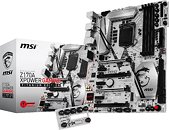Friday, July 31st 2015

MSI to Fuse OC and Gaming Lines with Z170 Family
MSI is set to fuse its two premium motherboard lines - OC Series and Gaming, with its upcoming Z170 family. The company's upcoming Z170 XPower Gaming Titanium Edition is the first such product. This stunning looking board features a silvery-white PCB, with the frosty-silver scheme continuing on to the chipset and VRM heatsinks. Its main PCI-Express 3.0 x16 slots (which are wired to the CPU), feature a chrome tipped slot brace. Built in the ATX form-factor, the Z170 XPower Gaming Titanium Edition draws power from a combination of 24-pin ATX, 8-pin EPS, 4-pin ATX, and 6-pin PCIe power connectors. It uses a 16-phase VRM with tantalum capacitors, to condition power for the CPU. The CPU is wired to four DDR4 DIMM slots, supporting up to 64 GB of dual-channel memory.
Expansion slots include four PCI-Express 3.0 x16, from which three are wired to the CPU (electrical x16/NC/NC or x8/NC/x8 or x8/x4/x4); the fourth is electrical PCIe 3.0 x4 and wired to the PCH. Three PCIe 3.0 x1 slots make for the rest of the expansion area. Storage connectivity includes two M.2 32 Gb/s slots, two SATA-Express 16 Gb/s, and eight SATA 6 Gb/s ports. Display outputs include one each of DisplayPort and HDMI. USB connectivity includes 4 USB 3.1 slots, which include a mixture of type-A and type-C, with a physical type-A port pointing "forwards." MSI AudioBoost 3 audio solution, and Killer E2200 NIC make for the rest of its connectivity. The board features a detachable module with OC controls, called the OC Dashboard. This plugs into headers around the voltage measurement points. You also get automatic overclocking via a rotary knob. MSI will launch this board in its first wave of socket LGA1151 motherboards.
Expansion slots include four PCI-Express 3.0 x16, from which three are wired to the CPU (electrical x16/NC/NC or x8/NC/x8 or x8/x4/x4); the fourth is electrical PCIe 3.0 x4 and wired to the PCH. Three PCIe 3.0 x1 slots make for the rest of the expansion area. Storage connectivity includes two M.2 32 Gb/s slots, two SATA-Express 16 Gb/s, and eight SATA 6 Gb/s ports. Display outputs include one each of DisplayPort and HDMI. USB connectivity includes 4 USB 3.1 slots, which include a mixture of type-A and type-C, with a physical type-A port pointing "forwards." MSI AudioBoost 3 audio solution, and Killer E2200 NIC make for the rest of its connectivity. The board features a detachable module with OC controls, called the OC Dashboard. This plugs into headers around the voltage measurement points. You also get automatic overclocking via a rotary knob. MSI will launch this board in its first wave of socket LGA1151 motherboards.

29 Comments on MSI to Fuse OC and Gaming Lines with Z170 Family
But the Z170 chipset has 20 lanes, I should be able to run a GPU at full 16x and a NVMe PCIe SSD at 4x with no issues right? Also Sli at Full 8X/8X and 4x NVMe. (8x/4x/8x)
Made the picture grainy so it looks better when you buy it ? :p, i be tempted if the price was not extreme which i think it would be.
5160x4000 is too large to upload here
rghost.net/6WH2zCyjD/image.png
It is normal even good board with solid elements (170$)with normal OC options . but for the color does not have to bee designate titanium.
iwant, i want.....
:D
To answer your second question: Yes. Since you have 3 devices, they can match up with what Intel planned for the Z170 chipset: GPU/GPU/NVMe device @ x8/x8/x4, respectively.
The Z170 chipset is the southbridge. The CPU has 20 lanes of PCIE 3.0 for graphics. The Z170 has 20 lanes of PCIE 3.0 for M.2 support, SATA-Express, SATAIII, USB 3.1/3.0/2.0 and other "slower" devices.
That is a MASSIVE increase in bandwidth for a southbridge. Intel's enthusiast chipsets from P67 and Z68 (mated to Sandy Bridge CPUs) to the current Z97 (in line with Haswell and Broadwell) all had only 8 lanes of PCIE 2.0. Even the X99 adopters are limited to 8 lanes of PCIE 2.0 for their slower devices (of course, they get 40 lanes for CPU PCIE, though).
THAT is the main reason for my finally upgrading from my Ivy Bridge i7-3770K and a Z77 ASUS MAXIMUS V EXTREME to a Skylake i7-6700K and a solid Z170 motherboard. I really like full support by everyone (Intel and the board makers) of M.2 PCIE 3.0x4 for a whopping 32Gbps theoretical throughput along with better support for NVMe PCIE SSDs. No more workarounds to get your Z97 motherboard to recognize an M.2 PCIE 3.0x4 SSD (I'm looking at you ASRock).
So, yes, this generation of chipsets really do bring something more to the table.
Gotta say though... this one is sexy as hell!
You can take it from there, I suppose...
Every review I've read of motherboards with Killer NIC has them performing the same, or worse, than Intel's offerings (within statistical margins of error). There have also been many issues reported with the Killer NIC software, including but not limited to high CPU usage and BSODs. There's a thread on MSI's forum about how to remove the Killer NIC software and install generic Qualcomm drivers to avoid these issues. There's a thread here about how to do the exact same thing.
In contrast, I have never had a bad experience with an Intel ethernet adapter. From my first Pentium 3 board to my current Ivy Bridge, every Intel NIC I've used has installed and worked and given me zero trouble. The Internet agrees with me.
Killer NIC is snake oil BS that Qualcomm is dumping into the market at discounted rates to gain market share. MSI would rather save a few pennies and put these on their boards than stump up for decent Intel hardware; I would rather support a motherboard manufacturer that doesn't cheap out on their customers.